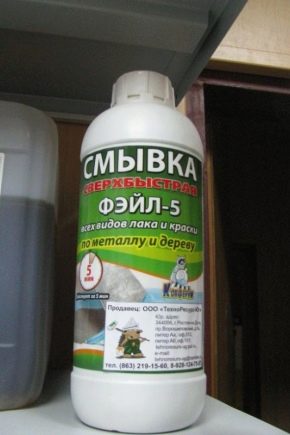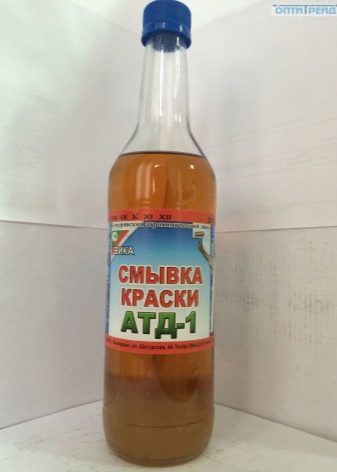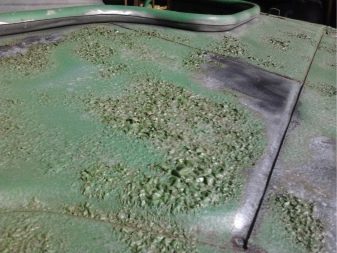Removing paint from metal: types and composition of liquids

Renovation is a small life, which, by the way, can arise both in an old family nest and in a newly rebuilt dwelling with a fine finish. Since people are not always sufficiently satisfied with the internal technical and visual state of the living space, they begin their titanic work of introducing a piece of their soul into the interior, reworking everything that came before them. But not all internal work can be easily changed. For example, before you start painting interior parts, you should get rid of old paint, primarily on metal surfaces.

In this situation, logic, fearlessness and action come to the rescue. In fact, the first thing that comes to mind is chemistry. But it is not the only one ... Let's try to understand the types and methods of cleaning metal from paint, how this or that method can be better, better quality and more reliable.
Views


In order not to get confused in a building materials store, you should find out how you can remove paint from metal.
Three types of this action will push you to the right decision:
- Mechanical method. Rough, long-term, hard, conservative way of getting rid of. You should resort to it in the event that you urgently need to remove this old paint of a terrible color from a metal surface, and only a grinder with a grinding attachment or sharp metal spatulas are at hand.
- Thermal method. It would seem that everything is simple: he heated the area, scraped off the paint. Slowly but surely, you can achieve the desired result. Moreover, the method is very complex and time consuming. And it is problematic to heat the metal section so that the pieces of paint begin to crumble by themselves.
- Chemical method. In the modern era of nanotechnology, it is alien to not using scientific approaches. The most popular old paint remover is a paint remover. This is a special remover of various compositions that easily removes old paint on metal.



Since such cleaners have a wide variety, we will highlight the main ones that you should pay attention to when buying:
- means for removing water-based and oil paints from bricks or reinforced concrete;
- universal washes - a kind of "panacea" for any type of paint on any surface;
- powder products, they help get rid of epoxy and polyester coatings on metal surfaces;
- express wash, which allows you to achieve an instant effect in a short time (sometimes no more than 15 minutes). These include a variety of alkali-free sprays.
- Making the right choice, you should dwell in more detail on the composition of this washer.



Composition
Any type of cleaner contains a certain chemical minimum that will lead to the desired result. After processing the problem area, the paint softens and peels off the metal. This process continues until the wash has evaporated. Therefore, for surfaces coated with paint in several layers, the application takes place in several stages. To speed up the process of rejection, in addition to the main component - caustic soda - such cleaners are added with agents that slow down evaporation: wax or paraffin. Such complex washes require "postoperative" support - degreasing before applying a new color.


Gels and pastes deserve special attention. They are the most versatile and easy to apply to any surface. There is no need to fear the high consumption of this type of cleaner. They are applied evenly, easily and efficiently: they do not drain even from vertical surfaces and the ceiling. And at the same time they have maximum efficiency.


There are also two folk remedies for exfoliating old paint from metal. The well-known caustic soda (soda) is at the top of this list.
In second place is a homemade mini-recipe for a mixture for processing metal surfaces:
- 250 ml of ammonia;
- 1 liter of water;
- 2 kg of chalk.


10% ammonia is mixed with a liter of water, where chalk is then added. It turns out a homogeneous gruel, which is applied to problem areas. After a few hours, the paint will swell up and can be wiped off the surface. Of course, this method is very outdated, the modern market is ready to offer to replace it with new, more effective means to combat unwanted paint on metal. Modern specialists quite deliberately and without fear use specialized washing mixtures in practice.


Consumption
The paraphrased Russian folk wisdom says: "How many bottles do not take, still run twice". Of course, in such a painstaking situation as renovation, I really want to avoid such a development of events. Typically, each bottle of remover contains a brief or complete description of the liquid used. This can be either a programmed product per square meter, or detailed instructions for consumption for all occasions: the number of grams per surface area, due to the thickness of the treated coating.


There is another way to determine how much wash you need for your specific application. Construction professionals recommend taking a closer look at the thickness of the paint layer so that the amount of remover is equal to this indicator. It may not be the most convenient, but most often it helps to achieve the goal.


Regardless of how much remover you use, remember that the thicker the paint layer, the more you will need to remove it. And the longer it will take to work on the problem area.
How to remove?
Let's take an example of the most complex processes: removing powder paint from a metal surface and removing color from aluminum. The first method is complicated by the fact that the powder is one of the most durable paints and varnishes, which does not lend itself to mechanical cleaning at all.

To remove such a coating from metal, you must perform the following procedure:
- The most important thing is to protect yourself and your health: wear rubber gloves and safety glasses.
- If the object of cleaning is not too large and can be taken in hand, then it is recommended to completely immerse it in the washing solution.
- Until the paint completely swells, the solution must be constantly stirred and, if necessary, heated (the chemical properties of the remover for powder paints work best at high temperatures). After that, it remains to wait no more than 20 minutes.
- When there is a visible effect of the process, take out our item and clean it from the peeled paint with a spatula.
- Sodium phosphate, or rather, its solution, will help to remove the remnants of paint and detergent. Of course, you can also use a large amount of ordinary water. But it must be constantly warmed up for maximum effect.



As for removing paint from aluminum surfaces, this issue should be approached with the utmost care. Aluminum is a very capricious and even delicate material. In modern washes, alkali is widely used as the main component. And for this metal, this is practically death.Experienced builders and repairers advise using special sprays without alkali in the composition, which can be easily sprayed onto aluminum surfaces of any type, even in the most inaccessible places.

Speaking about simpler and more understandable cases of removing old paint from metal, several stages of this process can be distinguished:
- clean the surface from dust and dirt;
- apply a cleaning agent to a metal surface (you can use a brush, roller or spray gun);
- wait for the time indicated on the wash package;
- remove peeled pieces with a stiff brush or spatula;
- repeat the wash if necessary;
- get rid of the remnants of the cleaning agent (the list of drugs is usually indicated by the manufacturer on the packaging or in the instructions for use).


The step-by-step instructions are good for novice builders who first decided to clean metal products from paint. Although there are a number of nuances, all the subtleties of this process can only be learned empirically.
Helpful hints
To make the process of cleaning a metal surface from old paint as easy, fast and effective as possible, you should pay attention to such simple truths:
- preliminary washing of the surface to be cleaned from paint. Ordinary household chemicals will fit you, since they have not only cleansing, but also degreasing properties. It is thanks to this preliminary preparation that the chemical remover will be able to penetrate deep into the metal coating;
- If you have chosen a product that does not contain paraffin or wax, ordinary polyethylene will help you to reduce the evaporation rate of the remover. They should cover the solvent-treated surface and maintain the time specified in the instructions;
- often for the next stage of cleaning (after peeling off the paint), hard metal brushes, scrapers or spatulas are used. However, builders of large-scale projects share one more secret: removal of swollen paint using a high-pressure water jet;


- in order not to damage the metal itself (painted base), it is necessary to choose a remover designed for a specific material and a specific paint. Otherwise, as in the case of aluminum coatings, it is fraught with deterioration of the base and poor quality result;
- mixing solvents of different composition is not dangerous, but completely ineffective. You can not only waste money and time, but also backfire;
- constant and maximum ventilation of the room in which cleaning is carried out is not just important, but one of the most important and obligatory conditions of the process.
The laborious and complex process of cleaning metal products from old paint turns into magic when you take into account all the nuances and recommendations of experienced specialists. Correctly selected means, adherence to all precautions and the will to defeat the annoying coating are the main components of success in this matter.


How to remove paint from metal using a cleaner, see the video.













The comment was sent successfully.